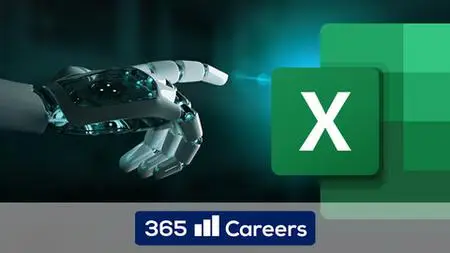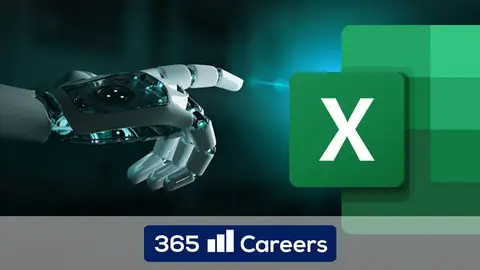Excel For Data Science And Machine Learning
Last updated 3/2022
MP4 | Video: h264, 1280x720 | Audio: AAC, 44.1 KHz
Language: English | Size: 2.53 GB | Duration: 5h 54m
Last updated 3/2022
MP4 | Video: h264, 1280x720 | Audio: AAC, 44.1 KHz
Language: English | Size: 2.53 GB | Duration: 5h 54m
Perform Machine Learning and Advanced Statistical Analysis On Your Own - Even If You Don't Code! 100% in Excel
What you'll learn
Use This Course to Improve Your Excel Skills
Learn How to Perform Machine Learning Techniques on Your Own - No Coding Skills Required
Fundamental Statistical Concepts
Grasp the Intuition Behind Advanced Statistics
How to Use Excel for Advanced Statistical Analysis
Improve Your Analytical Thinking
Linear Regression
Multiple Linear Regression
Logistic Regression
Cluster Analysis
K-Means Clustering
Decision Trees
Requirements
Understanding of Basic Statistics
Beginner Excel Knowledge
Description
Why machine learning and data science in Excel?Do data scientists and data analysts use Excel at all?The answer is a resounding “Yes, they do!”Few people in an organization can read a Jupyter Notebook, but literally everyone is familiar with Excel. It provides the direct, visual insight that both experts and beginners need to apply the most common machine learning methods. Plus, it is naturally suited to data preparation.In fact, the simplicity of Excel lowers barriers to entry and allows you to undertake your own data analysis right away. Even if you are not a computer science graduate with Python coding skills, this course will teach you how to perform machine learning and advanced statistical analysis on your own.Excel is the perfect environment to grasp the logic of different machine learning techniques in an easy-to-understand way. All you need to do is get started, and in no time, you will be able to fully understand the intuition behind ML algorithms without having to code at all.So, if you are not into programming but you want to break into data science, statistical analysis, and machine learning, and you aspire to become a data analyst or data scientist, you’ve come to the right place.Machine learning methods we will cover in the course:Linear regressionMultiple Linear RegressionLogistic RegressionCluster AnalysisK-Means ClusteringDecision TreesYou will learn fundamental statistical and machine learning concepts, such as:Regression coefficientsVariabilityOLS assumptionsROC curveUnderfittingOverfittingDifference between classification and clusteringHow to choose the number of clustersHow to cluster categorical dataWhen to standardize dataPros and Cons of clusteringEntropy (Loss function)Information gainAs you can see, we aim to teach you the foundations of machine learning and advanced statistical analysis in a software that is truly easy to understand. And the best part is, once you finish this course, you will have the transferable theoretical knowledge you’ll need if you decide to dive into the advanced frameworks available in Python.So, if you are passionate about machine learning but you don’t know how to code, then this course is the perfect opportunity for you. Click ‘Buy Now’, get excited, and begin your ML journey today!!
Overview
Section 1: Introduction
Lecture 1 What Does the Course Cover?
Lecture 2 What Is Machine Learning?
Lecture 3 Types of Machine Learning
Section 2: Simple Linear Regression
Lecture 4 Linear Regression: Introduction
Lecture 5 Linear Regression
Lecture 6 Linear Regression Model (Graphical Representation)
Lecture 7 Formatting Excel Spreadsheets
Lecture 8 First Regression in Excel
Lecture 9 What Is OLS?
Lecture 10 Interpreting Regression Tables (Part 1)
Lecture 11 Decomposition of Variability
Lecture 12 Interpreting Regression Tables (Part 2)
Lecture 13 Interpreting Regression Tables (Part 3)
Lecture 14 Simple Linear Regression - Exercise
Section 3: Multiple Linear Regression
Lecture 15 Multiple Regression Analysis
Lecture 16 Multiple Linear Regression (Example)
Lecture 17 Mutiple Linear Regression (Results)
Lecture 18 OLS Assumptions
Lecture 19 OLS Assumptions: Linearity
Lecture 20 OLS Assumptions: No Endogeneity
Lecture 21 OLS Assumptions: Normality and Homoscedasticity
Lecture 22 OSL Assumptions: No Autocorrelation
Lecture 23 OLS Assumptions: No Multicollinearity
Lecture 24 Dummy Variables
Lecture 25 Dummy Variables - Exercise
Lecture 26 Making Predictions Using Linear Regression
Lecture 27 Making Predictions Using Linear Regression -Exercise
Section 4: Linear Regression Practical Example
Lecture 28 Practical Example (Part 1)
Lecture 29 Practical Example (Part 2)
Lecture 30 Practical Example (Part 3)
Lecture 31 A Note on Multicollinearity
Lecture 32 Feature Scaling
Lecture 33 Practical Example (Part 4)
Section 5: Logistic Regression
Lecture 34 Introduction to Logistic Regression
Lecture 35 From Linear to Logistic Regression
Lecture 36 Logistic vs. Logit Function
Lecture 37 Applying Logistic Regression in Excel
Lecture 38 Interpreting Regression Coefficients
Lecture 39 Logistic Regression with XReal
Lecture 40 Understanding the Logistic Regression Summary (part 1)
Lecture 41 Understanding the Logistic Regression Summary (Part 2)
Lecture 42 ROC Curve
Lecture 43 Binary Predictors for Logistic Regressions
Lecture 44 Underfitting and Overfitting
Lecture 45 Testing the Logistic Model
Section 6: Cluster Analysis
Lecture 46 Cluster Analysis (Definition)
Lecture 47 Cluster Analysis (Application)
Lecture 48 Clustering vs Classification
Lecture 49 Cluster Analysis (Math Prerequisites)
Section 7: K-means Clustering
Lecture 50 K-means Clustering
Lecture 51 K-means Clustering in Excel
Lecture 52 K-means Clustering with Xreal
Lecture 53 Choosing the Number of Clusters
Lecture 54 Clustering Categorical Data
Lecture 55 Standardization
Lecture 56 Clustering and Regression
Lecture 57 Clustering (Pros and Cons)
Lecture 58 Types of Clustering
Lecture 59 Market Segmentation (Part 1)
Lecture 60 Market Segmentation (Part 2)
Section 8: Decision Trees
Lecture 61 Decision Trees
Lecture 62 Entropy (Loss function)
Lecture 63 Information Gain
Lecture 64 Decision Trees in Excel (Part 1)
Lecture 65 Decision Trees in Excel (part 2)
Lecture 66 Decision trees (Prediction)
Section 9: Machine Learning in the Cloud
Lecture 67 Machine Learning in the Cloud
Lecture 68 Setting up Azure Machine Learning Studio (AMLS)
Lecture 69 First Experiment in AMLS (Part 1)
Lecture 70 First Experiment in AMLS (Part 2)
Lecture 71 Publishing a Web Service
Lecture 72 The Future of Machine Learning
You Should Take This Course If You Want to Understand Machine Learning Fundamentals,Don't Know How to Code but You Want to Perform Machine Learning On Your Own? This Is the Perfect Course for You,This Course Is Great If You Aspire to Become a Data Analyst or a Data Scientist



